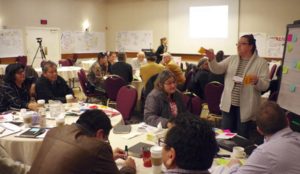Nookiiwin Tribal Council workshop helps communities plan for the future

By Rick Garrick
THUNDER BAY—The key components, benefits, and challenges of comprehensive community plans were the focus at Nokiiwin Tribal Council’s Comprehensive Community Planning workshop, held March 20-21 in Thunder Bay.
“We need a long-term plan for our community,” says Pic Mobert Councillor John Kwissiwa. “It’s important, too, to have a vision of infrastructure, community-owned businesses, how the community could look like in the next 10 years, put it on a piece of paper or a computer or make a model, and show that to the people — this is where we want to go, this is where we are going to take you and we need your support.”
Kwissiwa says a 10-year plan for his community could include subdivisions on the waterfront, access to Highway 17, more businesses for the community, a community arena, a new firehall, and an area for heavy equipment.
“I think it is important to put it on a picture and show the people the visual aspects of what our community could look like,” Kwissiwa says. “The most important part of this session here is our younger generation. With all of the struggles we are having today, I think it is important to fix them so the younger generation doesn’t have the same trouble that we’re having.”
About 10 people attended the workshop from Pic Mobert, including Chief Wayne Sabourin and Deputy Chief Johanna Desmoulin.
“It’s been very engaging — there’s a lot of work ahead,” Sabourin says. “For me, it’s going to be probably a three, maybe to 10 year, work plan because there is a lot of stuff we want to do out there and the band members want to do it.”
Sabourin says the workshop is a learning tool that enabled him to learn how other communities are working, as well as strategies presented by Eco Plan, an organization from British Columbia that facilitated the workshop along with Animbiigoo Zaagi’igan Anishinaabek, a Nokiiwin community that completed their comprehensive community plan a few years ago.
“It opens your eyes; it makes you think out of the box,” Sabourin says. “And to think out of the box is important in today’s world for Indigenous people.”
Sessions scheduled for the first day of the workshop included: CCP Overview; Getting Started: What does it take?; Communications and Engagement; and Meeting Design and Facilitation. The second day’s scheduled sessions included: Where are we now?; Where do we want to go?; How do we get there?; and Have we arrived?.
“[We attended] to learn more about the comprehensive community planning process — we’ve received some funding to hire a coordinator, but we haven’t done that yet, so this is an opportune time to learn from some communities who have already started their process,” says Biinjitiwaabik Zaaging Anishinaabek Councillor Frank Hardy. “It will be so important to have a blueprint for moving forward and being prepared. We want this to be community driven by membership and funneled down to Chief and Council — that’s how we hope this process works, so membership gets their say as to what they want.”
Nokiiwin executive director Audrey Gilbeau says comprehensive community planning has been a priority for all six of the Nokiiwin communities since 2012.
“While it has always been a core mandate, it has never been properly resourced,” Gilbeau says. “Our communities have been talking about long-term planning, seven generation planning, looking at how to best utilize what they have to better serve the needs of their communities, but also how to generate additional revenue to feed into what the hopes and the dreams of the communities are.”


